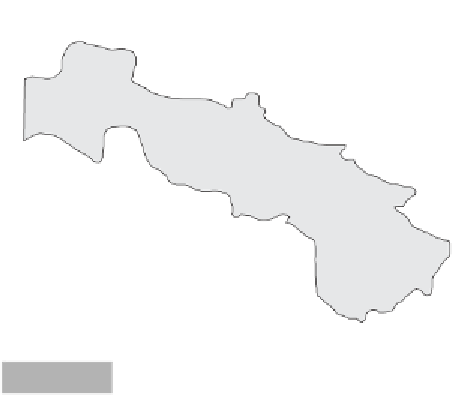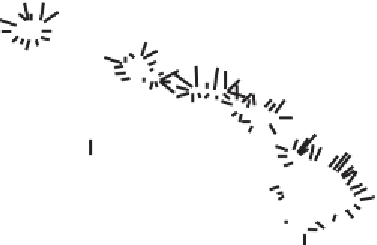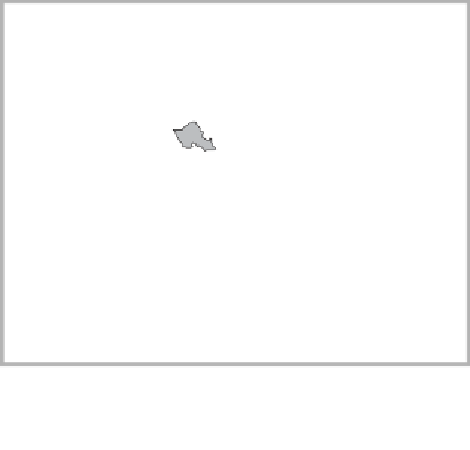Geoscience Reference
In-Depth Information
which had a run-up height of 38.2 m - had a magnitude
of 4.0. The other great Sanriku tsunami of 1933, which
ranks as the second largest recorded tsunami in Japan,
had a magnitude of 3.0. Japanese tsunami have
between 1 and 10 per cent of the total energy of the
source earthquake. This can be related to a tsunami's
magnitude using the Richter scale (Table 10.3). Only
earthquakes of magnitude 7.0 or greater are responsi-
ble for significant tsunami waves in Japan, with run-up
heights in excess of 1 m. However, as an earthquake's
magnitude rises above 8.0, the run-up height and
destructive energy of the wave dramatically increase. A
magnitude 8.0 earthquake can produce tsunami run-
up of between 4 and 6 m in height. Intensities of 8.75
generated the 38.2 m wave run-up of the Great Meiji
Sanriku tsunami.
The Imamura-Iida magnitude scale has acquired
worldwide usage. However, because the maximum run-
up height of a tsunami can be so variable along a coast,
Soloviev proposed a more general scale as follows:
Direction of tsunami
approach
13.7
11.5
8.2
16.4
Kauai
10.7
Molokai
11.2
10.9
9.1
Maui
Oahu
9.4
16.7
Run-up height
of tsunami
11.5
(= 10 m)
Spot height (m)
16.4
Hawaii
0 50 100 150km
6.1
Run-up heights of the 1 April 1946 tsunami around the
Hawaiian Islands following an Alaskan earthquake (based
on Shepard, 1977).
Fig. 10.16
exceeding 5 m. Coastlines where offshore depths
dropped off steeply were hardest hit, because the
tsunami waves could approach shore with minimal
energy dissipation. For these reasons, run-up heights
were spatially very variable. In some places, for
example on the north shore of Molokai, heights
exceeded 10 m, while several kilometres away heights
did not reach 2.5 m.
i
s
= log
2
(1.4
--
r
)
(10.2)
where
i
s
= Soloviev's tsunami
magnitude (dimensionless)
--
r
= Mean tsunami run-up height
along a stretch of coast (m)
Tsun
ami magnitude scales
This scale and its relationship to both mean and
maximum tsunami wave run-up heights are sum-
marized in Table 10.4. Neither the Imamura-Iida nor
the Soloviev scales relate transparently to earthquake
(Abe, 1979, 1983; Horikawa & Shuto, 1983; Hatori,
1986; Shuto, 1993; Geist, 1997)
Earthquake-generated tsunami are associated with
events registering more than 6.5 on the M
s
scale. Two-
thirds of damaging tsunami in the Pacific region have
been associated with earthquakes of magnitude 7.5 or
greater. Tsunami can be scaled according to the size
of their run-up. The following scale, known as the
Imamura-Iida scale, was defined using approximately
one hundred Japanese tsunami between 1700 and
1960:
Earthquake magnitude, tsunami magnitude and tsunami
run-up heights in Japan (based on Iida, 1963).
Table 10.3
Earthquake
Magnitude
Tsunami
Richter Scale
Magnitude
Maximum run-up (m)
6
-2
<0.3
m
II
= log
2
H
rmax
(10.1)
6.5
-1
0.5-0.75
where
m
II
= Imamura-Iida's tsunami
magnitude scale
(dimensionless)
H
rmax
= maximum tsunami run-up
height
7
0
1.0-1.5
7.5
1
2.0-3.0
8
2
4.0-6.0
8.25
3
8.0-12.0
8.5
4
16.0-24.0
8.75
5
>32.0
On the Imamura-Iida scale, the biggest tsunami in
Japan - the Great Meiji Sanriku tsunami of 1896,
Source: Based on Iida, 1963.






































